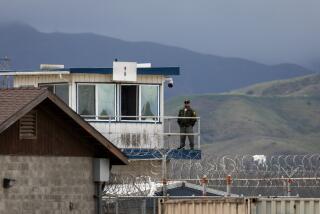Most States Have Already Stiffened Sentences on Youths
- Share via
If the schoolyard killings in Arkansas trigger a new wave of tougher penalties on adolescent murderers, it will come after nearly every state already has changed its laws to make it easier to prosecute juveniles as adults.
In the last six years, virtually every state has lowered the age at which kids can be tried as adults, expanded the types of crimes that could send a youngster to an adult prison and ended confidentiality rules on juvenile lawbreakers, said Vincent Schiraldi of the Center on Juvenile and Criminal Justice in Washington.
Every state but Hawaii now allows juveniles as young as 14 to be tried as adults. Twenty-two states allow such prosecutions at age 14, five allow them at age 13, two at age 12 and three at age 10. The rest have no minimum at all.
“There seems to be an irresistible rush to judgment following idiosyncratic, high-notoriety cases like this one,” Schiraldi said, referring to the massacre at a schoolyard in Jonesboro, Ark., that left five dead and 10 wounded. The alleged assailants are two boys, ages 11 and 13.
It’s too soon to tell whether the case will prompt Arkansas lawmakers to lower the age at which young criminals can be treated as adults. The attack was so freakish, so aberrant that it is the last type of case that should influence how the law deals with the vast majority of criminal kids, said Gerry Glynn, a University of Arkansas-Little Rock law professor who tracks juvenile prosecution trends.
“In the state of Arkansas there are 13,000 delinquent acts committed by children every year, but it’s cases like this that set public policy,” he said.
Yet because the suspects in the Jonesboro case are too young to be tried as adults, even the federal government is thinking about stepping into the case.
The Justice Department is exploring whether bringing charges under federal law “would add anything to the prosecution or the situation in Jonesboro,” U.S. Atty. Gen. Janet Reno told reporters at her weekly briefing.
The lowest age allowed under federal law for adult prosecution is 13, and the circumstances for such prosecution are “quite limited,” said Kent Markus, Reno’s deputy chief of staff. The federal government can do so if a state is unable or, more importantly, declines to bring a prosecution, or if there is a substantial federal interest in bringing such a charge.
Several states have taken steps to ensure that juveniles can be prosecuted as adults for particularly heinous crimes. In 1996, Wisconsin lowered the age by which juveniles can be prosecuted as adults to 10. Milwaukee lawyer Robin Shellow is challenging the constitutionality of that law by appealing the conviction of a 13-year-old Milwaukee girl who helped her boyfriend stab and strangle her grandmother’s nurse in order to steal her car.
Many corrections experts say locking up juvenile offenders in adult prisons for longer periods only makes them worse when they get out. “I think it’s a mistake to do that,” said Thomas F. Geraghty, a law professor at Northwestern University. “The best way to strengthen our juvenile court system is to make more sentencing options available to our judges.”
Some states, such as Minnesota, have experimented with a “blended” system, in which juveniles are given adult sentences, which are then suspended while the lawbreaker goes into juvenile detention. Depending upon how the youngster reacts to juvenile imprisonment, the sentencing judge can either reduce the adult sentence or impose its full weight.
Glynn said he favors blended sentencing because it combines both options.
Two tough new juvenile crime bills are pending in Congress, however, including a bill to let prosecutors, and not judges, decide whether juveniles should be tried as adults. Congress also approved $1.5 billion in grants to states that toughen their guidelines to make prosecuting juveniles as adults more routine and less discretionary.
Asked about the effect of the shootings on congressional legislation to stiffen provisions against juveniles, Reno said she is certain the “tragedy will have a great deal to do with how we approach youth violence. . . . I think it is important that we not let a case cause us to go to one extreme or the other. We have got to continue to work through these issues in a very balanced way.”
Last year, Justice Department figures showed that the 1996 arrest rate for violent crime among juveniles dropped 9.2% from 1995, marking the second year in a row that such arrests had declined nationwide. By comparison, juvenile arrest rates for crimes including murder, rape, robbery and assault rose 67% from 1987 to 1994.
Many have attributed the recent drop in violent crime to several factors, including tougher punishment for juveniles found responsible for serious offenses. In announcing the drop in crime last year, Reno specifically mentioned the president’s funding for community policing and tougher laws to attack violent youth gangs.
But others suggest the recent drop in youth crime has been driven by other factors--including a general decline in crime--and that tougher punishment for juveniles can actually have adverse effects.
One 1997 study at the University of Nevada, Las Vegas, found that juveniles who were sent to jail were twice as likely to commit another crime than those who were sent to a diversion program. The study of 271 at-risk youths also found that the juveniles sent to jail were three times more likely to commit a violent crime than those sent to other programs.
Fritz reported from New York and Krikorian from Los Angeles. Times staff writer Ronald J. Ostrow in Washington and researcher Lianne Hart in Houston contributed to this story.
More to Read
Sign up for Essential California
The most important California stories and recommendations in your inbox every morning.
You may occasionally receive promotional content from the Los Angeles Times.













